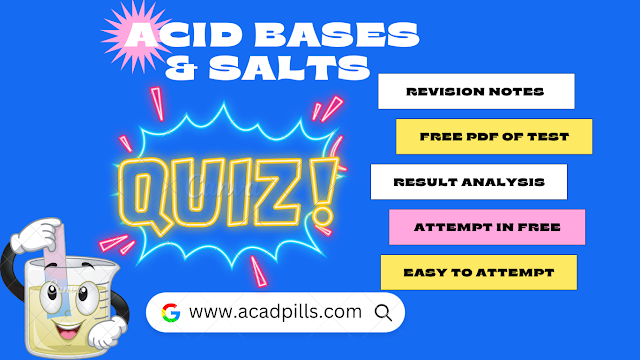Table of Contents
About Class 10 Science Chapter 2 – Acids bases and salts
Note – To Attempt test scroll down to this page
| Queries | Answer |
|---|---|
| DIFFICULTY LEVEL | Moderate to hard |
| EASIEST TOPIC | Concept of pH scale |
| HARDEST TOPIC | Preparation and uses of Sodium Hydroxide, Bleaching powder, Baking soda, Washing soda and Plaster of Paris |
| WEIGHTAGE | 5 marks as per latest sample paper NOTE- it may vary between 5-8 |
| TYPE OF QUESTIONS ASKED | 2 questions of 1 marks 1 question of 3 marks Notes – This date is as per latest sample paper of 2023 |
| NUMBER OF QUESTIONS IN EXAM | Approx 3-5 questions every year |
| IMPORTANCE OF CHAPTER | Will help in understanding Acids bases and salts |
| HANDWRITTEN NOTES OF THIS CHAPTER | Class 10 science handwritten notes pdf download |
| IMPORTANT TOPIC FOR EXAM | Basic definition, Preparation and uses of compounds given |
REVISION NOTES OF ACIDS BASES AND SALTS
| IMPORTANT DEFINATIONS OF CHAPTER 2 |
|---|
| Acids: Substances which turn blue litmus solution red are called acids. Acids are sour in taste |
| Bases: Substances which change red litmus solution blue are called bases. They are bitter in taste. |
| Mineral Acids: Acids which are obtained from minerals like sulphates, nitrates, chlorides etc. are called mineral acids, e.g., H2SO4( Sulphuric acid), HNO3(Nitric acid) and HCl(Hydrochloric acid). |
| Organic Acids: Acids which are obtained from plants and animals are called organic acids. e.g. citric acid, ascorbic acid, tartaric acid, lactic acid, acetic acid. |
| Hydronium Ions(H3O+): They are formed by reaction of H+ (from acid) and H2O. It is because H+ is unstable. |
| Strong Acids: Acids which dissociate into ions completely are called strong acids. E.g. H2SO4, HCl |
| Weak Acids: Acids which do not dissociate into ions completely are called weak acids E.g. Citric acid, acetic acid. |
| pH scale: A scale for measuring hydrogen ion concentration in a solution. The pH of a solution is defined as the negative logarithm of hydrogen ion concentration in moles per liter. pH =-log [H+] pH =-log [H3O+] where [H+] or [H3O+] represents concentrations of hydrogen ions in solution.
|
| Indicators – Indicators are substances which indicate the acidic or basic nature of the solution by their colour change. Universal Indicator: A universal indicator is a mixture of indicators which shows a gradual but well-marked series of colour changes over a very wide range of change in concentration of H+ ion. |
Chemical properties of acids
|
Chemical properties of Bases
|
| Common Name | Chemical name/ Chemical formula | Preparation | Uses |
|---|---|---|---|
| Washing soda | Sodium carbonate decahydrate Na2CO3.10H2O |
|
Manufacture of borax, caustic soda, softening of hard water |
| Baking soda | Sodium hydrogen carbonate NaHCO3 |
NaCl+NH3+CO2+H2Oà NaHCO3 +NH4Cl | Used as antacid, ingredient of baking powder |
| Bleaching powder | Calcium oxychloride CaOCl2 |
By the action of chlorine on dry slaked lime Ca(OH)2+Cl2CaOCl2+H2O |
Bleaching clothes, used as oxidizing agent, disinfecting water, manufacture of chloroform |
| Plaster of Paris | calcium sulphate hemihydrate
CaSO4 .1/2H2O |
CaSO4.2H2O → CaSO4.1/2H2O + 3/2H2O | Plastering fractured bones, making toys, decorative materials, statues |
| EQUATIONS OF ACIDS,BASES AND SALTS |
|---|
| Acid + Metal à Salt + Hydrogen gas
|
Base+ Metal àSalt + Hydrogen gas
|
Base + Acid ——> Salt + Water
|
| Acids give hydronium ions in water
|
Bases generate OH– ions in water
|
| On heating, baking soda liberates CO2
|
| On mixing plaster of Paris with water, gypsum is obtained
|
General Instructions
- Your test contains multiple choice questions with only one answer. There are total 30 questions.
- This is a 25 min test. Each question is of 50 second .
- You need to select 1 options out of 4. you can’t leave the test in between once it is started.
- You can attempt the test unlimited time.
- Each question is of 20 points.
- No Negative Marking.
- You can view your Score after finishing the test.
Fill your Name in 1st box and Roll no. in 2nd box and Click on START THE QUIZ
Acid,Bases and Salt TEST
Please fill the above data!
Name : Apu
Roll : 9
Total Questions:
Correct: | Wrong:
Attempt: | Percentage:
Note – Please give you valuable feedback in the
comment section below also Comment Your Score in the comment section.
Please consider sharing this post with your friends to help them score well in their upcoming exams. We have also uploaded other Study materials on our website.
ALSO READ
- Shobhit nirwan notes class 10 pdf Download
- Digraj singh rajput class 10 sst notes pdf download
- Class 10 Shubham pathak notes pdf download
- Class 10 social science map work 2022-23
- Sample paper class 10 english 2022-23 with solutions
PDF download - Class 10 social science sample paper 2022-23 with
answer pdf download
| COMMUNITY NAME | JOIN LINK |
|---|---|
| TELEGRAM CHANNEL – Acadpills | JOIN NOW |
| FACEBOOK PAGE – Acadpills | FOLLOW NOW |
| INSTAGRAM HANDLE – Acadpills | FOLLOW NOW |
| YOUTUBE CHANNEL – Acadpills | SUBSCRIBE NOW |
| TWITTER – Acadpills | FOLLOW NOW |


